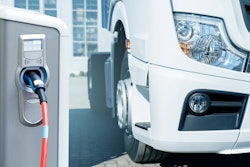
The future of fleet optimization is electric, and it’s already taking shape. Global electric truck sales grew by almost 80% in 2024, with the number of EV models available growing in response to rising demand and decreased battery costs. The catalyst for this change is clear; electrifying your fleet unlocks greater operational efficiency, savings and control.
Electric fleets are cheaper to maintain and charge compared to traditional fuel-powered fleets. EVs can save fleet operators 9% on operating costs, even with the cost of installing and maintaining charging infrastructure factored in. Most fuel-powered vehicles waste nearly 80% of the energy contained in their fuel before it even reaches the wheels. Electric vehicles, on the other hand, experience a lesser 11% energy loss, converting nearly 90% into motion. Not to mention the environmental impacts that result from this. EVs eliminate 100% of tailpipe emissions and offer a lifecycle emission savings of about 60% compared to gasoline vehicles.
Beyond savings and sustainability, EVs offer visibility and real-time control that traditional fuel-powered fleets simply don’t provide. When paired with smart charging and energy management software, fleet operators can access data on charging status, optimize energy on-site, and optimize turnaround time of vehicles at the depot. This data allows operators to keep a close eye on battery health, pre-plan charging schedules and reduce downtime that can cut into profits.
Navigating fleet electrification
The key to navigating fleet electrification begins with understanding your fleet’s unique needs and daily patterns. From route lengths to vehicle downtime, these factors will help determine the type of charging infrastructure and schedules required to support the fleet’s entire journey. A strategy should account for the specific type of fleet—whether company-owned or employee-owned—and the different charging options available, such as depot, at-home, worksite, and in-route charging. EV fleets also introduce special use cases that operators will need to consider, such as back-to-home compensation for drivers charging at home.
Installing charging infrastructure and pre-planning charging schedules is just the beginning. To successfully integrate EVs into daily operations, fleet operators need to ensure that the chargers installed are reliable and capable of charging vehicles fully during scheduled sessions. One study found that EV charger reliability and availability are the biggest barriers for fleet operators on the fence about switching to electric vehicles. Overcoming these concerns starts with gaining better insight into how chargers are performing and maximizing charging at the depot.
Fleet operators (and those providing charging services to them) can benefit from deeper visibility into the health of their charging network to keep up with maintenance and increase network uptime. This visibility also enhances the utilization of existing infrastructure, helping organizations get the full value from their current depots and facilities while enabling the integration of smart energy management systems that support more intelligent, energy-efficient charging practices.
The integration of EV charging and energy management platforms is crucial for operators to achieve operational excellence. In truth, the journey to fleet electrification can be complex and challenging without these tools in place. Without 24/7 charger monitoring and energy optimization or pre-planned charging schedules, fleets that mindlessly connect to chargers as they arrive at the depot risk blowing a fuse. Lack of insight into charger allocation and availability can leave drivers stranded or stuck waiting. Both of these scenarios risk delayed deliveries and lost revenue.
To meet operational demands, smart charging solutions must be compatible with fleet owners' existing operating systems and have the interoperability to work with various charger models. This will ensure the fleet operators experience long-term success with an electric fleet, regardless of what hardware they opt for or upgrade to in the future.
How to align EV charging with operational demands
For fleet electrification to be considered an operational success, aligning EV charging with your operational goals is critical. As introduced above, a solution for fleets of all sizes and purposes is a centralized platform for EV charging and energy management.
These platforms equip operators with:
● Insight-driven dashboards: Along with metrics on driver behavior, route efficiency, average vehicle speed, etc., fleet operators can gain new insights into charger status and charging station conditions through dashboards. With 24/7 charger monitoring and control, advanced reporting and analytics, and real-time alerts on charger health, operators can ensure everything is running properly.
● Self-healing algorithms: Charger maintenance and troubleshooting can be a drain on valuable resources, but with self-healing algorithms, fleet operators can remotely address up to 80% of operational issues with chargers. This allows fleets to maintain an available and stable charger network that doesn't rely on maintenance crews working to identify or fix individual charger issues.
● Energy management: Charging schedules can be planned ahead of time based on when the fleet is expected to arrive at the depot, when it needs to leave for its next route and how much energy the EV needs to complete the route. A large amount of energy is needed to charge multiple vehicles at the same time, causing operators to be cautious of energy availability. By incorporating smart energy management tools, fleet operators can also balance power between the charging site and the grid through bidirectional charging, ultimately reducing electricity costs and grid strain during peak demand periods.
These capabilities can significantly improve depot charging experiences. Incorporating EV charging management software for energy planning and infrastructure optimization makes EV fleets even more scalable and cost-effective, especially given the higher expenses and unpredictability of public charging. Smart energy planning enables more EVs to be charged simultaneously without jeopardizing grid stability, allowing operators to ramp up their electrification efforts and roll out even more EVs on the road.
Your fleet, recharged
With a clear strategy and the right EV charging management software in place, operators can unlock the full benefits of fleet electrification and gain peace of mind knowing their drivers will stay on schedule with reliable charging built into their routes. The road ahead will require additional planning and updates as your fleet expands and evolves, but it will ultimately result in greater TCO savings, operational efficiency and a greener future. Those who invest in fleet electrification today will gain the performance, savings and resilience needed to lead in the years to come.















![Pros To Know 2026 [color]](https://img.sdcexec.com/mindful/acbm/workspaces/default/uploads/2025/08/prostoknow-2026-color.mduFvhpgMk.png?ar=16%3A9&auto=format%2Ccompress&bg=fff&fill-color=fff&fit=fill&h=135&q=70&w=240)


